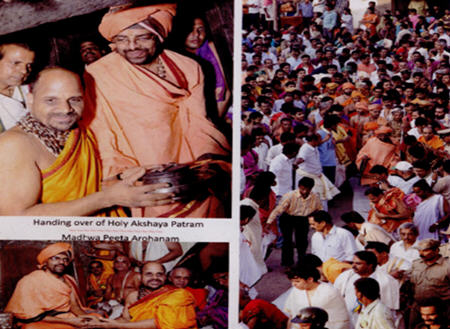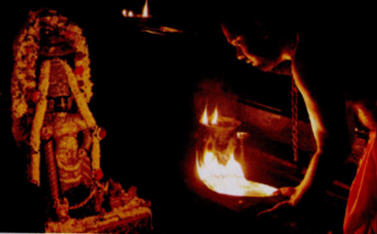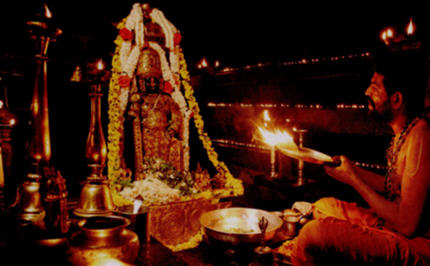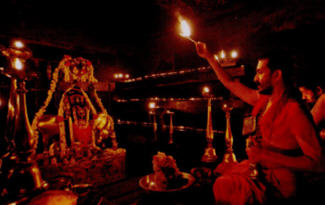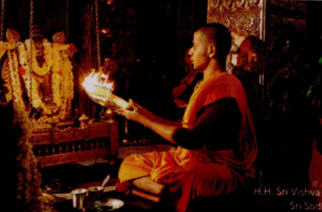The preliminaries start a year before the paryaya ceremony. The foremost among those rituals are
1. Baale unhurt
2. kaki unhurt
3. Katie mahout
4. batter mahout
1. Baaale unhurt
All this is done on an auspicious day about a year before the Paryaya festival. Plantain and Tulsi groves are formally set up on that day.
Each paryaya swamiji requires Tulsi leaves for daily service at the Krishna Matha and plantain leaves for feasts. Banana is needed for offerings to the deity. Hence the swamiji has to start cultivating these plants in the gardens belonging to his Matha so that by the time the paryaya period starts the rituals can commence.
On the day of mahout, priests pray to the nine planets first. Then Matha workers carry the Tulsi seedlings and the plantain which is to be planted. The procession moves towards the Krishna Matha. The royal elephant and other paraphernalia of the Matha participate in this ritual. They offer prayers at the temples of Chandreswara and Anantheswara. They also pray before Krishna’s shrine and offer coins. The prayer goes like this, “Please bless us so that there is no dearth of Tulsi for your worship and plantain leaves for dinner.” They also bow to the deities of Sri Mukhyaprana and Sri Madhvacharya and go back to their Matha. Then they plant Tulsi saplings and banana plants.
2. Kaki mahout
Within two months of celebrating the Bale mahout, they celebrate Kaki mahout. Thousands of people are fed during the period of paryaya. During special festivals, about 5,000 to 10,000 people are fed, so it is important to have considerable stock of rice. The procession starts from the Matha. A pack of rice is decorated and kept in a palanquin. It is covered with a silken cloth. Devotees go behind the palanquin with packs of rice on their head. All officers of the Matha participate in the procession. They pray at the temples of Chandreswara and Anantheswara.
The swamiji conducts this ritual himself. Other swamijis are also invited to the Matha and honoured.
3. Katie mahout
This is celebrated about six months before the commencement of the paryaya. After collecting rice, arrangements are made to gather firewood for cooking, which is why this ceremony is held.
Storing firewood in an artistic manner is the specialty of Udupi. Firewood is piled up in the shape of a beautiful chariot. It is visible in the North-East corner of the Madhva Sarovara.
Artists observe this ritual to start building this beautiful chariot out of rugged pieces of wood. After propitiating the nine planets, the procession starts with workers carrying loads of firewood. They salute deities in different temples and reach the place behind the cattle-shed where the chariot of firewood is to be constructed. After ritual of purifying the ground, artists begin their work.
Many skilled artists pile up firewood and arrange it in the shape of a chariot, 55 feet high. A few days before the Katie mahout of the next paryaya this chariot is dismantled and the firewood is used for cooking.
4. Batter muhurta
This ritual takes place about seven or eight weeks before the paryaya. It is meant to gather paddy from the new crop before the paryaya ceremony. All these rituals are observed to gather leaves to serve food. They collect rice and firewood for cooking. The sole aim is continuation of the tradition of mass feeding. That is why Lord Krishna of Udupi is known as “Anna Brahma.”
After the prayer, the procession starts from the Matha. A bag of paddy is placed in a palanquin and covered with silken cloth. After saluting the deities in different temples, the procession enters the Badagu Maalige.
The Badagu Maalige is the official storehouse for the paryaya. It is on this day that authorities of the next paryaya enter this place. The pack of paddy is placed on a platform and the priest offers rituals of worship. The manager of the paryaya Matha offers fruits and remuneration to scholars. From that day, the new paryaya Matha takes charge of the building.
Another ritual also takes place the same day. By that time, construction of the chariot of firewood is complete. A decorated dome is brought along with the procession. It is ceremoniously handed over to the chief architect and placed on top of the chariot. This marks the end of preliminary rituals of paryaya.
The Pre-Paryaya Tour:
About four to five months before the Paryaya ceremony, the swamiji goes on a pilgrimage to different holy places. This is known as Paryaya Puurva Sancaara. After the paryaya, the swamiji is not supposed to move out of Udupi. So he visits different places to meet his disciples and invites them for the paryaya festival beforehand. He is supposed to visit all centers of pilgrimage from Kanyakumari to Badarikashram and offer services to the deities in those places to obtain blessings.
On an auspicious day, the swamiji offers special prayers to his deities and starts on pilgrimage. He visits places like Kanyakumari, Rameshwaram, Tirupathi, Mathura, Brindavan, Dwarka, Gaya, Kashi, Prayag, Hrshikesh, Haridwar and Badari etc. After finishing the tour of South and North India, he returns to his district.
Afterwards, he visits the pilgrim centers of the district and finally enters the Udupi town in an auspicious moment. During this tour to different towns, devotees invite the swamiji and honour him. They also contribute liberally for the expenses of the paryaya.
Pura Praveesa:
About 10 to 15 days before the paryaya festival, the swamiji concludes his tours and ceremoniously enters the town of Udupi. The entire town is decorated to welcome him.
A big crowd is seen at the joodu katte at the Udupi Mangalore Road on that day to welcome the swamiji. If the swamiji enters the city from Shimoga side, the reception is arranged near the Kadiyali temple on the Udupi-Karkal route. As soon as the swamiji reaches the place, he is garlanded by leaders and dignitaries of the town. Flowers and fried rice are sprinkled on the route.
From the mandap at the joodu katte, the swamiji is taken to the Car Street in procession. Replicas of great saints and deities of the Matha are placed in the palanquin and taken in the procession. Musicians play, scholars chant Vedic hymns. The swamiji is seated in a decorated chariot. The deities are in a palanquin.
Streets are decorated up to the Car Street. Different arches and mandaps are constructed en-route and they are named after the pontiffs of that Matha. When the procession reaches Car Street, the swamiji descends from the chariot and walks up to Chandreshwara, Anantheshwara to reach the Krishna Matha and offer prayers.
At the entrance of his Matha, the nine planets are propitiated and the swamiji enters the Matha. Citizens honour the swamiji in a public function at Car Street. He is profusely garlanded. The swamiji announces his new plans and projects to be undertaken during the tenure of his paryaya and seeks the co-operation of citizens.
Hore Kaanike:
A few days before the paryaya, devotees bring rice, jaggery, pulses, vegetables, coconuts and other objects needed for mass feeding during the festival of paryaya and donate them to the swamiji. These objects are brought in trucks, carts and head loads. The processions pass through different streets of Udupi and enter the Krishna Matha. The swamiji accepts these contributions and blesses devotees.
Olipe:
This is a ceremony in which both the swamijis, the one who hands over charge and the other who takes charge, donate rice and vegetables to other swamijis of Udupi. All provisions are taken out in procession and sent to different Mathas.
This is arranged because all pilgrims visiting the paryaya festival and staying in different Mathas must be fed and looked after properly. Therefore, a token of the contribution is given by the swamiji to different Mathas so that they can offer hospitality to visiting pilgrims. This is arranged as a token of co-operation.
Invitation to Paryaya:
A day before the paryaya festival, the swamiji goes to different Mathas in procession and personally invites swamijis for the paryaya rituals.
The heads of other Mathas invite the swamiji to their respective Mathas before the paryaya and arrange a grand feast in honour of the swamiji by offering money as well as other objects like sandal paste.
Festival arranged by the outgoing swamiji:
The day following that of Makara Sankramana is celebrated as Churnotsava. There are no festivities the following day. The third day is allotted to the outgoing swamiji to celebrate his last special services. The fourth day is the day of paryaya.
Normally, the festivals fall as per this schedule: January 14-Sankramana. January 15 -Churnotsava, January 16 – Rest, January 17 – festival arranged by the outgoing swamiji, January 18 – The paryaya festival.
A special feast is arranged by the outgoing swamiji on the day before the paryaya. His responsibilities come to an end with the Brahma Rathotsava at night. The next day, he has to perform the nirmaalya visarjana puujaa only. Afterwards, it is the duty of the swamiji who takes charge the next day.
The Festival of Paryaya:
The swamiji who is to take charge of the Krishna Matha goes to a place called Danda Tirtha about 10 kilometers south of Udupi on the previous night. It is the place where Sri Madhvacharya studied in his childhood. He made a canal though his ritual-stick to irrigate the gardens of his teacher,. That pond came to be known as Dandatiirtha.
At about 3.00am, the swamiji gets up and bathes in the holy pond and starts the journey to Udupi. At about 4am, he reaches the outskirts of Udupi. A big crowd of devotees welcomes the swamiji at a place known as joodu katte. The other swamijis of Udupi, except the one who is to hand over charge, assemble there. The swamiji who is to hand over charge stays back at the Krishna Matha to welcome the new paryaya swamiji.
The route from the joodu katte to Car Street is decorated with festoons and lights. All buildings are illuminated. The arches and festoons represent traditions of preceptors. Different kinds of drums, trumpets and musical instruments are played. The music enlivens the entire area.
As soon as the would-be parayaya swamiji reaches the joodu katte, other pontiffs and devotees assembled there welcome him. He will now have the good fortune of serving Lord Krishna for the next two years.
The swamijis who come to welcome the paryaya swamiji are dressed in silken shawls and head-dress. They sit on their palanquins. The deity of the would-be paryaya Matha is placed in a palanquin and taken at the head of the procession.
The route is well decorated. Trained elephants are placed in the front row. This is followed by different kinds of tableaux. Troupes of singers and pipers participate in the procession. There are vehicles carrying deities and priests chanting hymns from the Vedas. The deity of the Matha rides in an ornate golden palanquin. Thousands of people gather on the streets as well as balconies of houses along the route to witness the scene. The procession moves slowly, covering one kilometer in two hours.
On reaching Car Street, the swamijis descend from the palanquin and walk on the white cloth spread on the road. They circumambulate Car Street and reach Krishna Matha.
The swamiji salutes the deity of Krishna through the Kanakas' window. Priests pray to the nine planets and offer grain and money to learned Brahmins to appease the planets. From there, the swamiji goes to the temple of Chandreswara and Anantheswara.
At the entrance of Sri Krishna Matha, the outgoing swamiji receives the new swamiji and leads him inside, holding his hands. They first descend to the Madhva Sarovara, wash their hands and feet and enter the sanctum sanctorum.
When the two swamijis enter the sanctum sanctorum, the other swamijis proceed towards the building known as Badagu Malige, sit on their decorated seats and wait for the paryaya swamiji.
Paryaya Ceremony:
The swamiji enters the Matha and places his box of deities in the tiirtha mandapa and does the aarati. Then both the swamijis enter the sanctum sanctorum and pray before the deity. They also pray before the deity of Mukhyaprana and prostrate before the deities of Sri Krishna, Mukhyaprana and Garuda at the Chandrashala Hall. Then the important ritual of handing over charge takes place in the room known as Simhaasana. Only a few officials of the Matha participate in this ritual transfer of powers. The new paryaya swamiji places the box of deities in the sacred seat and does aarati. Then the outgoing paryaya swamiji sits on the seat of Madhvacharya. He takes the would-be paryaya swamiji by his side and honours him by offering sandal paste and other objects of honour. The outgoing swamiji gets up from the seat of Madhvacharya, holds the hands of the new incumbent and makes him sit on the seat. Then he himself sits by his side. Soon after the ascent, the swamiji is officially known as the paryaya swamiji. The swamijis of the eight Mathas get few such occasions of occupying this sacred seat sanctified by the association of the great Acharya himself. From the moment the swamiji occupies this seat, he directs all activities and rituals as the representative of Sri Madhvacharya.
Transfer of the Aksaya Paatra:
After exchanging the seats, the two swamijis enquire about each other's welfare and proceed towards the deity of Sri Madhvacharya at the entrance of the sanctum sanctorum. The outgoing swamiji hands over the Aksaya Paatra, age-old vessels preserved from the time of Madhvacharya, the ladle and keys to the shrine. With this ritual, the management of Sri Krishna Matha is officially transferred to the new paryaya swamiji.
In the Badagu Maalige:
From here, the swamiji proceeds towards the Badagu Maalige building. There, the new swamiji honours other swamijis by offering sandal paste and other objects of honour. In the time of Sri Vadiraja, the paryaya congregation used to be held in this place.
Congregation at the Arranging open theatre:
The last programme of the ceremony is a big congregation known as durbar at the Rajangana. All the swamijis come in procession at about 7am to the auditorium. The place can accommodate about 20,000 people. After chanting of hymns from the Vedas the two swamijis bless devotees. The outgoing swamiji bids farewell to everyone and the new paryaya swamiji announces projects for the improvement of facilities at the Krishna Matha. Leaders and luminaries from a diverse cross section of society felicitate the new paryaya swamiji.
